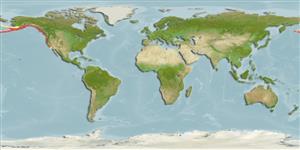>
Pleuronectiformes (Flatfishes) >
Pleuronectidae (Righteye flounders) > Hippoglossinae
Etymology: Eopsetta: Greek, eos = dawn, aurore + Greek, psetta = grouper (Ref. 45335); jordani: Named after David Starr Jordan, great inciter of ichthyology in the USA (Ref. 6885).
Environment: milieu / climate zone / depth range / distribution range
Écologie
marin démersal; profondeur 0 - 550 m (Ref. 6793). Temperate; 67°N - 31°N, 172°E - 117°W
Northeastern Pacific: Bering Sea coast of Alaska to Islas Los Coronados, northern Baja California, Mexico.
Length at first maturity / Taille / Poids / Âge
Maturity: Lm 43.0, range 40 - 44 cm
Max length : 53.0 cm TL mâle / non sexé; (Ref. 56527); 70.0 cm TL (female); common length : 42.5 cm TL mâle / non sexé; (Ref. 56527); poids max. publié: 3.7 kg (Ref. 56527); âge max. reporté: 35 années (Ref. 55701)
Description synthétique
Morphologie | Morphométrie
Épines dorsales (Total): 0; Rayons mous dorsaux (Total): 87-101; Épines anales 0; Rayons mous anaux: 67 - 79; Vertèbres: 41 - 44. Dorsal origin over middle part of eye. Caudal longest in middle, ending in a broad 'V'. Pectoral fins large, bluntly pointed.
Adults are found on sand bottom (Ref. 2850), usually in deep water (Ref. 9988). Feed on invertebrates and bottom fishes (Ref. 6885). Livers of large individuals are a rich source of vitamin A (Ref. 6885). Marketed fresh or as frozen fillets (Ref. 2850). Eaten steamed, fried, micro-waved and baked (Ref. 9988). Generally regarded as the premium Pacific coast sole (Ref. 9988).
Vinnikov, K.A., R.C. Thomson and T.A. Munroe, 2018. Revised classification of the righteye flounders (Teleostei: Pleuronectidae) based on multilocus phylogeny with complete taxon sampling. Molecular phylogenetics and evolution, 125:147-162. (Ref. 122998)
Statut dans la liste rouge de l'IUCN (Ref. 130435)
Menace pour l'homme
Harmless
Utilisations par l'homme
Pêcheries: commercial; pêche sportive: oui
Outils
Articles particuliers
Télécharger en XML
Sources Internet
Estimates based on models
Preferred temperature (Ref.
123201): 1 - 8.6, mean 5 °C (based on 420 cells).
Phylogenetic diversity index (Ref.
82804): PD
50 = 0.7500 [Uniqueness, from 0.5 = low to 2.0 = high].
Bayesian length-weight: a=0.00724 (0.00423 - 0.01239), b=3.08 (2.92 - 3.24), in cm total length, based on LWR estimates for this species & (Sub)family-body (Ref.
93245).
Niveau trophique (Ref.
69278): 4.1 ±0.67 se; based on food items.
Résilience (Ref.
120179): Milieu, temps minimum de doublement de population : 1,4 à 4,4 années (K=0.16; tm=7-8; tmax=35; Fec=400,000).
Prior r = 0.45, 95% CL = 0.29 - 0.67, Based on 1 stock assessment.
Fishing Vulnerability (Ref.
59153): High vulnerability (62 of 100).
Climate Vulnerability (Ref.
125649): Moderate to high vulnerability (52 of 100).
Nutrients (Ref.
124155): Calcium = 30.7 [12.2, 52.1] mg/100g; Iron = 0.276 [0.140, 0.534] mg/100g; Protein = 17 [16, 18] %; Omega3 = 0.378 [0.181, 0.780] g/100g; Selenium = 19.1 [9.5, 42.3] μg/100g; VitaminA = 14.9 [3.5, 66.2] μg/100g; Zinc = 0.349 [0.232, 0.525] mg/100g (wet weight);
